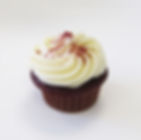buttercream types
Buttercream has different types; each type has its own flavour, taste and appeal.
1) Creamed
AMERICAN/BASIC: Icing sugar + softened butter + milk + vanilla.
CREAM CHEESE: Icing sugar + cream cheese + softened butter + vanilla.
2) Meringue
SWISS: Egg whites + light corn syrup + white sugar + softened butter.
FRENCH: Egg yolks + homemade sugar syrup + butter.
ITALIAN: Homemade sugar syrup + egg whites + white sugar + softened butter.
3) Custard-based
ERMINE buttercream (flour buttercream): Flour + sugar + milk + butter.
GERMAN buttercream: Milk + sugar + egg yolks + cornstarch + butter.
CREAMED
AMERICAN/BASIC (AMBC):

This is the most commonly used buttercream. It's easy and quick to make and a hit with kids. It’s also great to use as a cake finish and when piping details like buttercream flowers or borders. It can also be made with margarine, or a combination of butter and margarine.
Cons: Very sweet and can have a grittier mouth-feel when compared to other frosting. If made with margarine it can also leave a greasy feel on the lips but withstand warmer climates.
CREAM CHEESE: This is a creamy delicious frosting and commonly associated with red velvet and carrot cakes. With the addition of some lemon juice it can also have a more tart flavour.
Cons: The addition of cream cheese makes this a much softer frosting than the American buttercream. It doesn’t hold up well in warm environments, and doesn’t work well as a cake finish as it won’t hold sharp corners or piped details.
MERINGUE
SWISS MERINGUE (SMBC):

I prefer this buttercream, however it is very rich due to the high butter to sugar ratio. It is light and not super sweet tasting like American buttercream. The egg whites and sugars are lightly whipped together over a water bath, then whipped into a thick meringue until cooled. Softened butter is added to make a glossy and fluffy buttercream. It is a very stable frosting and is commonly used to fill and finish fine wedding cakes. Works like a dream under fondant.
Cons: Requires some time and patience, as well as a double boiler and candy thermometer, which can be intimidating. It will soften quickly in warmer conditions.
ITALIAN (IMBC): Similar to swiss buttercream, except sugar and water are first cooked to the “soft ball stage”, then drizzled into egg whites before being whipped into a fluffy meringue. Softened butter and flavourings are added to the meringue, similar to the method for Swiss. This tastes and looks like swiss buttercream. Very smooth and creamy with all of the same attributes as SMBC. IMBC is a little more stable than SMBC in warmer weather since the sugar is cooked to a higher temperature.
Cons: Pouring hot sugar into whipping egg whites is not for the faint of heart. This can take a lot of trial and error to master.
FRENCH (FMBC):
Same process as IMBC, except egg yolks are used instead of whites. Some recipes call for the whole egg, but traditionally only yolks are used.
This frosting is every butter lover’s dream, silky and smooth with a rich flavour. French buttercream works well as a cake filling or as a soft buttercream finish.
Cons: French buttercream is a very soft frosting, so it doesn’t work well if you’re looking to achieve sharp corners or pipe details. It does not work well under fondant or hold up well in warmer environments.
CUSTARD BASED
ERMINE:
To create a thick custard-like consistency; flour, sugar, and milk are cooked together. Once cooled, this mixture is slowly added to creamed butter along with flavouring.

Very smooth and simple to make. It’s a great compromise if AMBC is too sweet and gritty for you, but meringue-based buttercream seems too difficult to make or you want to avoid eggs in your frosting. It holds up well in warm conditions, pipes easily and can be used under fondant. Fun fact: while many people believe cream cheese frosting to be the best pairing for red velvet cake, Ermine frosting is what’s called for in most of the older, traditional recipes.
Cons: It’s more labor-intensive than AMBC and can have a heavier or thicker mouth-feel than a meringue-based buttercream.
GERMAN:
Same as ermine, except made with a traditional cooked custard (or thick pastry cream) consisting of milk, sugar, egg yolks and cornstarch. Very smooth and flavourful. Works well as a cupcake topping or cake filling.
Cons: German buttercream is a softer frosting, with similar drawbacks as the other softer buttercreams. It also has a yellowish tint, which can make it difficult to colour.
















